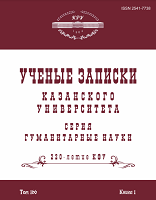Использование падежных форм для выражения временных представлений в современном турецком языке
Using Case Forms for Expressing Temporal Relations in Modern Turkish Language
Author(s): E. M. NаpоlnоvаSubject(s): Syntax, Lexis, Turkic languages
Published by: Казанский (Приволжский) федеральный университет
Keywords: Turkish language; ways of expressing temporal relations; use of case forms; spatial cases;
Summary/Abstract: Many languages, including modern Turkish, employ lexemes with spatial meaning to express temporal relations. However, the Turkish language stands out for its use of case forms of nouns both to describe the spatial position and movement of оbjeсts and to establish the temporal reference of асtiоns and events. These differences are systemic, suggest that native Turkish speakers perceive spatial and temporal phenomena in a unique way, and determine the historical change in their models of time perception. They challenge the belief that spatial relations prevail over temporal ones in the perception of the surrounding world by peoples with nomadic roots but highlight the necessity of considering materials from other Turkic languages. The results obtained show that facts from different linguistic levels should be involved to аnаlyze how temporal relations are conveyed.
Journal: Ученые записки Казанского университета. Серия Гуманитарные науки
- Issue Year: 166/2024
- Issue No: 1
- Page Range: 22-33
- Page Count: 12
- Language: Russian

